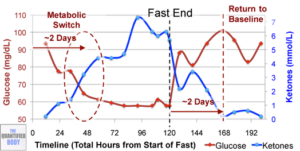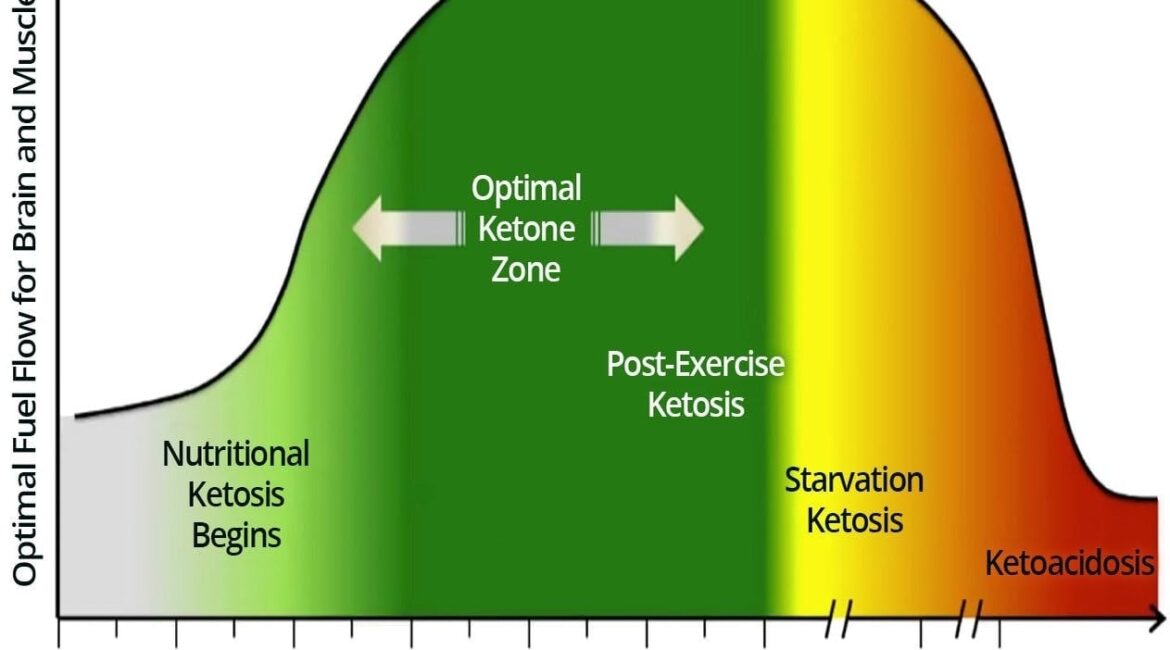“Ketosis is bad”. This seems to be a common misconception among doctors and dieticians. This misconception is the result of conflating the nutritional state of Ketosis, with Diabetic Ketoacidosis (DKA), a serious condition.
So what is Ketosis? It is a metabolic state in which the body relies primarily on fats, rather than glucose, as its main source of energy. Ketosis can occur as a result of extended fasting, or due to a diet designed specifically for the purpose.
Nutritional Ketosis
When we sufficiently limit carbohydrates in our diet, and replace them with healthy fats, glucose levels in the blood start to fall. This causes the liver to release its stored glycogen into the blood in the form of glucose. When liver glycogen levels are depleted, the body turns to fat to fuel its energy needs, and the liver starts metabolizing fats into molecules called ketones. Ketones can readily be converted to energy by mitochondria in the cells. In ketosis, ketones serve as the primary source of energy for the body.
The term Nutritional Ketosis was popularized by Stephen Phinney & Jeff Volek. Nutritional Ketosis signifies that the body is running on fat as its primary source of fuel, and one is not fasting to enter into ketosis.
In nutritional ketosis, as long as adequate insulin is maintained in the body, whether endogenous or injected (as in case of Type 1 or insulin dependent Type 2 diabetics), a perfect balance is maintained and ketone levels in the blood remain in a safe range (0.5-3mmol/L).
Starvation Ketosis
When fasting is used to enter ketosis, the resulting state is known as Starvation Ketosis.
When we do not eat for an extended period, the body’s glycogen levels get depleted. As a result, the body turns to stored fat for its energy needs, thus entering ketosis. Due to this, extended fasting is often used to enter the state of ketosis, thus flipping the body’s metabolic switch from burning glucose to burning fat for energy. The switching can happen anywhere between 24 to 48 hours of fasting, with mild ketosis arising in the initial stages. However, the ketone concentration rises with continued & prolonged fasting, and peaks after about 20 to 30 days (8-10mmol/L). Prolonged fasting to the point of starvation results in a condition called Starvation Ketoacidosis, which is different from Starvation Ketosis. The two should not be conflated.
To better understand how the levels behave on fasting, here is a self-explanatory graph showing Glucose & Ketone levels varying with duration of fasting:

Glucose & Ketone Levels Vs Fasting Duration.
Diabetic Ketoacidosis – The Dangerous State
This is primarily a Type 1 diabetic phenomenon and is known to occur in 2% to 5% of Type 1 diabetics. Though rare, it can also occur in insulin dependent Type 2 diabetics, with almost no endogenous insulin. DKA is a potentially life threatening complication of diabetes and is a consequence of shortage of insulin.
Three things occur in tandem in DKA — high blood sugar, extremely high level of ketones (ketoacidosis) and ketonuria. When insulin levels fall to extremely low levels, the body is unable to push glucose into cells. In response, the body starts metabolising stored fats into ketones in an uncontrolled manner. Ketone levels rise quickly, up to as much as 15-25mmol/L, causing the blood pH to alter, and affecting functioning of organs such as the liver and kidneys. This leads to critical illness and the patient needs immediate medical attention.
DKA can also be precipitated by certain illnesses, such as pneumonia & urinary tract infections. These illnesses cause higher levels of certain hormones to be produced in the body, such as adrenaline & cortisol. These hormones counter the effects of insulin, thus precipitating DKA.
Other causes of DKA include:
- Stress
- Physical or emotional trauma
- Misusing alcohol or drugs, especially cocaine
- Fasting or malnutrition combined with excessive alcohol consumption
- Certain medications, such as corticosteroids and some diuretics
- Acute major illnesses, such as pancreatitis, sepsis & myocardial infarction.
The symptoms of DKA include one or more of the following:
- Excessive thirst
- Frequent urination
- Nausea and vomiting
- Abdominal pain
- Weakness or fatigue
- Shortness of breath
- Fruity breath
- Confusion
- Dry or flushed skin.
DKA is a medical emergency and needs immediate hospitalization.
Top Image Credit: Jeff Volek & Stephen Phinney, 2012 -- The Art & Science of Low Carbohydrate Performance.


Excellent article!!
Thank You! I’m glad you liked it. 🙂